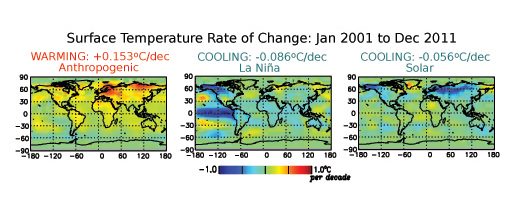Earth’s global warming during the first decade of the twenty-first century slowed to about half that from 1950 to 2000, even though greenhouse gas concentrations increased almost a factor of two faster. IPCC’s physical model simulations did not capture this lack of warming, motivating extensive scientific investigations of the “cause of the pause”.
Was the extra heat imparted by the increased greenhouse gas concentrations hiding in the ocean? If so where – perhaps the Pacific? Did excessive volcanic aerosols cool the globe sufficiently to counter a significant fraction of the warming? Might the observations themselves be faulty? Amplified by media commentary, the suggestions by these studies that “missing” mechanisms may be influencing climate exacerbated confusion among policy makers, the public and other stakeholders about the causes and reality of modern climate change.
But anthropogenic warming did not “pause” in trapping radiative energy from 2000 to 2015, nor did the rapid warming at the end of 2015 signify its resumption. Rather, as explained in a WIREs Climate Change review an observation-based study suggests that fortuitous timing of sustained La Niña conditions, declining solar irradiance and stratospheric aerosol increases mitigated 56%, 36% and 8% (respectively, for a total of 100%) of the 0.15oC per decade anthropogenic surface warming from 2001 to 2011.
Over the longer epoch from 1997 to 2013, sometimes termed a “slowdown” rather than a “pause”, Earth’s global surface temperature warmed more than from 2001 to 2011 because, although the anthropogenic warming was similar, La Niña, solar irradiance and volcanic aerosol cooling was less, cancelling 52% (34%, 13% and 5%, respectively) of the warming. Then, at the end of 2015 the amplification of the ongoing anthropogenic warming by El Niño produced a net global warming surge that propelled 2016 to be “the warmest year on record”.
The divergence of physical model simulations from observations that precipitated the notion of a “global warming pause” does not signify a crisis in climate science or understanding but simply the limitations of current physical climate models. The models projected more global warming than transpired in the early twenty-first century primarily because they did not generate the observed phase of La Niña cooling and may also have underestimated cooling by declining solar irradiance. A secondary reason is their use of incorrect radiative forcings. In neglecting to account for cooling from a slight increase in “background” stratospheric aerosols the physical models may have over overestimated global surface warming by a modest 0.013oC per decade. Using a new and better reconstruction of total solar irradiance reduces solar heating 0.01oC per decade.
Explaining succinctly to the public, policy makers and other stakeholders how natural decadal-scale processes may alter future climate will continue to challenge communication of the causes of climate change in the next twenty years. Since physical climate models cannot, as yet, simulate the phasing of natural sources of decadal variability, they may be expected to continue to overestimate or underestimate the real decadal-scale climate trends that may range from ~0 to +0.3oC per decade, depending on the net effect of natural and anthropogenic climate influences. The models’, as yet untested, abilities (or lack thereof) to realistically simulate complex nonlinear processes involving melting Arctic Sea Ice and slowing down of the Atlantic Meridional overturning circulation may compound the disparity of climate model projections with actual observations in the future.
Kindly contributed by:
Judith L. Lean
Space Science Division, Naval Research Laboratory, Washington DC
















